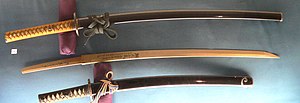Uchigatana
| Uchigatana (打刀?) | |
|---|---|

Uchigatana full exterior (upper section)
|
|
| Type | Sword |
| Place of origin | Japan |
| Production history | |
| Produced | Muromachi period (1392–1573) |
| Specifications | |
| Blade length | 60+ cm |
An uchigatana (?) is a type of Japanese sword worn by the samurai class of feudal Japan. The uchigatana was the descendant of the tachi.
The production of swords in Japan is divided into specific time periods:
From the Heian to the Muromachi Period, the primary battlefield sword was the tachi. Its long blade and sharp edge made it ideal for use on horseback. During the fifteenth century, the uchigatana came into use, and during the Muromachi Period (1336 to 1573) use of the uchigatana became widespread.
The word uchigatana can be found in literary works as early as the Kamakura Period, with uchi meaning "to strike" and gatana (katana) meaning "sword", so that uchigatana means "sword to strike with". The uchigatana was originally used only by individuals of low status or rank, such as the ashigaru.
Most uchigatana made during the early Kamakura Period were not of the highest standard, and because they were considered disposable, virtually no examples from these early times exist today. It was not until the Muromachi Period, when samurai began to use uchigatana to supplement the longer tachi, that uchigatana of higher quality were made. During the Momoyama period, the tachi was almost totally abandoned and the custom of wearing a pair of long and short uchigatana together (called the daisho) became the dominant symbol of the samurai class.
...
Wikipedia
